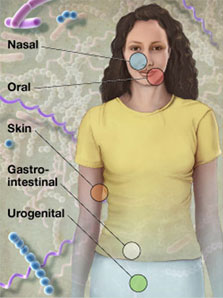 Many of us learned about cells in high school biology class. We learned that bodies are made up of different kinds of cells—skin, muscle, blood, etc. But most of us did not learn about the trillions of non-human, microbial cells.
Many of us learned about cells in high school biology class. We learned that bodies are made up of different kinds of cells—skin, muscle, blood, etc. But most of us did not learn about the trillions of non-human, microbial cells.
Those cells, or “microbiome,” are important for maintaining human health; if things go wrong with our microbes it can contribute to our risk for disease. But what is the microbial make-up of a healthy human being? What types of microbes are present, and what are they doing?
Microbe communities can be very different from one person to another. There is even a difference from one location to another on the same individual. Our microbial genomes record what we have eaten, where we have lived, and who we have been in contact with. We literally have microbial “ecosystems” in and on different parts of our bodies that differ drastically from one to another and supply a wide range of functions.
The scientific study of microbiology grew out of society’s desire to control pathogens and infectious diseases. Doctors always thought microbes were bad things to be gotten rid of, such as measles or strep throat. But most microbes do NOT make us sick. We are starting to recognize that microbes also keep us healthy, unless they become unbalanced. “Unbalance” can occur because of antibiotic usage, an unhealthy diet, or other variable. The end result may be an increased risk for chronic disease or health conditions such as:
• Acne
• Asthma
• Autism
• Cancer
• Autoimmune disease
• Diabetes
• Inflammatory bowel diseases
• Obesity
The study of microbiome is still in its infancy, but major strides have been made since the inception of the Human Microbiome Project (HMP) in 2005. “Knowing which microbes live in various ecological niches in healthy people allows us to better investigate what goes awry in diseases that are thought to have a microbial link,” such as Crohn’s disease, ulcers and obesity, said George Weinstock of Washington University in St. Louis, one of the project’s principal investigators.
For example, researchers at Baylor College of Medicine found fewer types of vaginal microbes in pregnant women (as opposed to non-pregnant women). The take-away? A pregnant, female body naturally reduces the diversity of her microbial species in the weeks leading up to birth so that the newborn — who developed in a sterile womb — can be exposed to the proper intestinal and vaginal bacteria when it goes through the birth canal. Exposure to mother’s bacteria is the signal to the infant’s immune system to start. A baby born by C-section does not get the same exposure to mom’s microbiome, and because of this difference, may be more likely to develop allergies and asthma.
Over the next year, we will examine the influence of “gut bugs” on nutrition, health, and behavior. Hopefully you will learn a lot more about your personal microbes and how food choice affects microbial levels and your risk for chronic disease.
Written by: Donna Green, Extension Educator, Family and Consumer Sciences, Ohio State University Extension, Erie County, green.308@osu.edu
Reviewed by: Bridgette Kidd, Healthy People Program Specialist, Ohio State University Extension, kidd.149@osu.edu
Sources:
http://biofrontiers.colorado.edu/news/five-things-about-the-microbiome
http://genome.wustl.edu/projects/detail/human-microbiome-project/
http://medicine.umich.edu/medschool/research/research-strengths/host-microbiome-initiative






